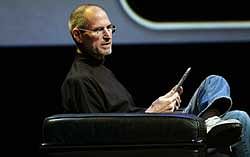

"We want to kick off 2010 by introducing a magical and revolutionary product today,” said Mr. Jobs, Apple’s chief executive.
Some models of the product will be available in 60 days, he said.
Mr. Jobs appeared energized but gaunt as he unveiled the iPad at a press event in San Francisco on Wednesday.
Its features and specifications, which have been grist for the Internet rumor mill for months, are finally sharply in focus: It will feature a 9.7-inch screen and a full virtual keyboard. It is a half inch thick and weighs 1.5 pounds. In addition, the iPad screen is multi-touch, meaning content on it can be manipulated with swipes and taps of the fingers.
The iPad is outfitted with Wi-Fi and Bluetooth Internet connectivity, and is powered by a 1-gigahertz Apple A4 chip and has 16 to 64 gigabytes of flash storage. Mr. Jobs described the iPad as “so much more intimate than a laptop and so much more capable of a smartphone with this gorgeous, large display.”
The most advanced model will cost $829 with 64 gigabytes of memory and connection to a 3G cellphone network.
The company also said AT & T will offer an unlimited data plan for $30 a month. It said the Wi-Fi-only models will be available in 60 days and those with cellphone connectivity will be available in 90 days.
During the event, Mr. Jobs demonstrated the iPad as a platform for watching video, streaming music, reading e-books, browsing photographs and playing games. The company also said third-party applications would be a big draw on the iPad.
The iPad will run “virtually every one” of the current catalog applications for the iPhone, numbering around 100,000 “virtually unmodified,” Scott Forstall, a senior vice president, said.
Mr. Forstall also noted that developers can modify their apps to take advantage of the large touch-screen display, just as Apple did with its calendar, iTunes, e-mail and You Tube apps. The iPhone SDK, a set of programming tools for developers, will be enhanced to support development of the iPad, and the new SDK will be released today.
“We think its going to be a whole other gold rush for developers as they build apps for the iPad,” Mr. Forstall said.
Among the partners at the San Francisco event that showed off new software compatible with the iPad: Gameloft, a game developer, which demonstrated a first-person shooter game on the iPad; Electronic Arts, and The New York Times.
Apple has been working on such a tablet computer for more than a decade, according to several former employees. But early prototypes, which used PC microchips, quickly drained batteries, and Apple executives could never figure out how or why people would want to use such a device, which lacks a traditional keyboard and computer mouse. Other companies, such as Microsoft, have sold tablet computers for years, but the category has never caught on with consumers.
But advances in technology have since made tablets more feasible. Battery technology has improved. Mr. Jobs said the iPad would have ten hours of battery life, enabling a user to “take a flight form San Francisco to Tokyo and watch video the whole way.”
Traditional QWERTY keyboards have also, to many people, become expendable. In 2005, Apple acquired Fingerworks, a company founded by two researchers at the University of Delaware to develop gesture-based computer interfaces. Their work has been integrated into the iPhone and now, the iPad. At the same time, an expanding class of smartphones like Google's Nexus One and the BlackBerry Bold have abandoned keyboards altogether.
The remarkable success of the iPhone and its cousin, the IPod Touch, have also shown a path forward for tablets. People have been willing to pay to customize those devices with a large pool of third-party tools, called applications, turning them into video game machines, compasses, city guides and e-book readers. There are now over 100,000 applications for the iPhone and iPod Touch, which are expected to generate $1.4 billion in revenue in 2010, according to an analysis by Piper Jaffray.